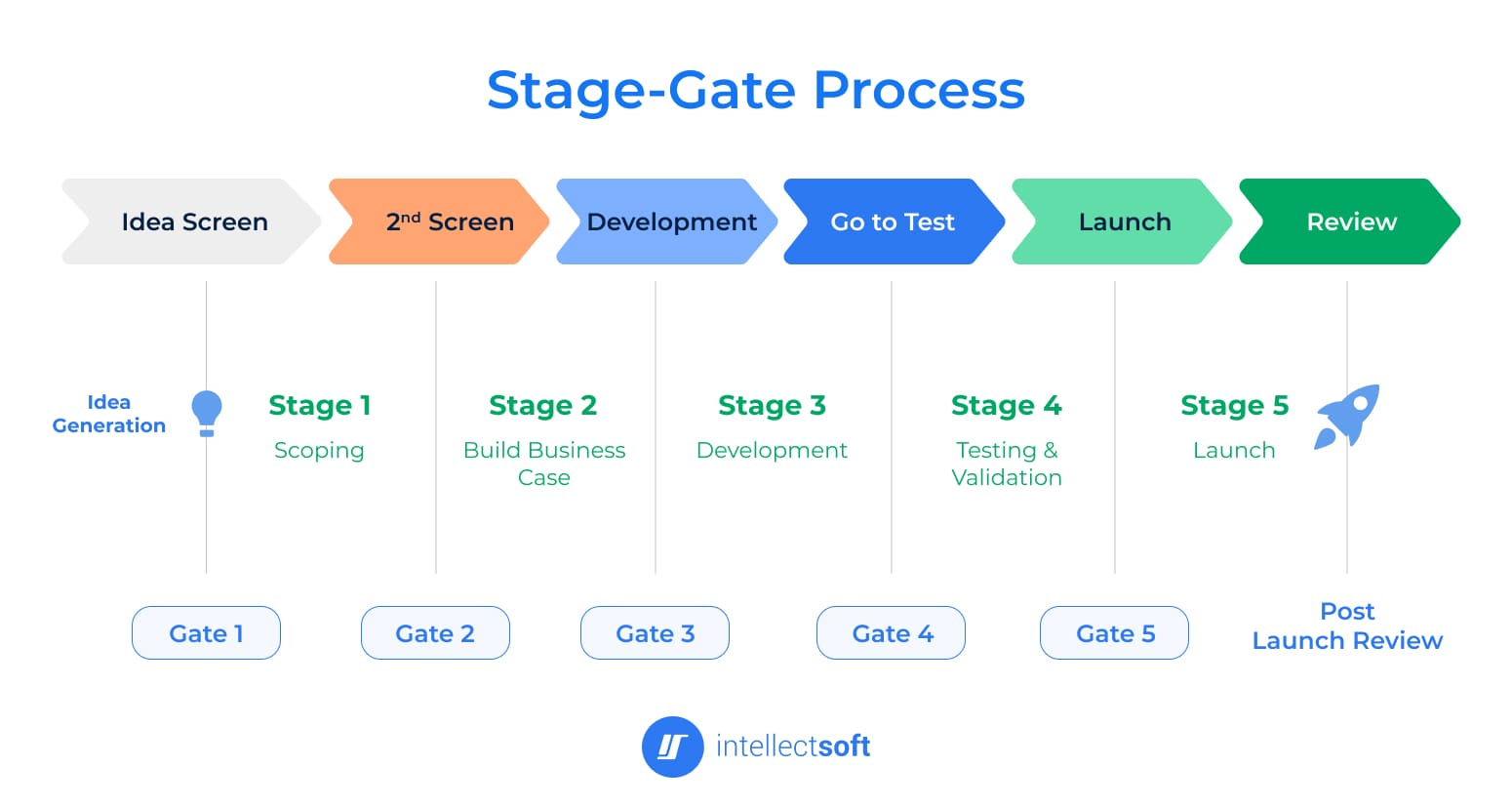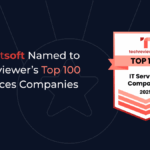The Stage Gate Process has a rich history and remains relevant in specific industries where risk management, compliance, and structured decision-making are crucial. However, its rigidity in fast-paced environments necessitates adaptation or hybridization with agile methodologies to remain effective.
Nowadays, IT teams want to find the right balance between classical and agile software development methodologies. While any of them might sound like a perfect solution theoretically, the practice might show otherwise. Agile projects grow into relentless scope creep without any direction, while heavily documented processes end up being heavily bureaucratic and inefficient.
If you want to find out more about what software development methodologies are out there and how we use them at Intellectsoft, check out our webinar recording from BrightTalk.
In this article, we explore how the Stage Gate Process is beneficial for IT teams. It emerged as a risk-reducing tactic for product development in other industries and now starts to gain traction in the digital realm.
What is the Stage Gate Process?
Stage Gate process is a project management technique that breaks down projects into distinct stages with decision points (“gates”) between them. Companies can use it in software development, but it’s not the most common approach.
The Stage Gate methodology has its roots in the 1960s within the New Product Development (NPD) practices of major pharmaceutical and aerospace companies. These industries dealt with complex projects requiring significant resources, risk management, and regulatory hurdles. The Stage Gate process template provided a way to break down these projects into manageable phases with clear instructions for go/no-go decisions.
How is the Stage Gate Process Used in SDLC?
In software development, the Stage Gate Process is reminiscent of hybrid methodologies like the Spiral Model and Rational Unified Process that connect the best of both polar opposites: Waterfall and Agile.
Stage Gate Process is rather a simplified alternative because the so-called “gates” in the sense of milestones are basically present in every other software development methodology out there. However, it does include ideation and business case creation, which are often left out in common SDLC workflows. In this regard, the Stage Gate Process offers a more holistic approach to product development where the actual production is a logical outcome of the business needs.
So, Which Projects is It Good For?
- Large, complex projects: For major software development initiatives, Stage Gate can provide structure and control.
- Highly regulated industries: Some industries have strict compliance requirements that benefit from the structured approach of Stage Gate.
- Risk-averse companies: For companies prioritizing risk mitigation, the decision points of Stage Gate can offer reassurance.
Alternatives to Stage Gate Process
- Agile methodologies: More iterative and adaptable, better suited for rapid changes and uncertain requirements.
- Lean development: Focuses on minimizing waste and delivering value quickly through feedback loops and continuous improvement.
Ultimately, the best approach depends on the specific project and the company’s needs. Keep in mind that unless you work in a heavily regulated industry, you don’t necessarily have to do everything by the Stage Gate book. Opt for optimizing if you like some parts of this approach and dislike others. Your team can hybridize the Stage Gate Process to have some understandable structure to follow while keeping the flexibility options, for example. It is better to follow what works best for you rather than adopting Scrum and then having robotic stand-ups where people are involved just formally.
5 Phases of the Stage Gate Process
Go! 🏇
You’re good to launch! The tech works, the market wants it, and the numbers add up. Time to hit the gas and execute the plan.
Kill It 🙈
Not every idea wins. Maybe tech hurdles are insurmountable, the market shifted, or costs outweigh benefits. Shutting down saves resources and lets you focus on better bets.
Hold On ✋
Hit a temporary stop sign. Maybe you’re waiting for key partners, the market needs time to evolve, or your team is busy elsewhere. Define clear conditions for restarting when things change.
Rework It 👷
The design needs tweaks, user feedback demands changes, or finances need fixing. Refine your plan, address issues, and re-enter the race with a stronger engine.
Go With Conditions 🚸
Proceed with caution! You get the green light, but specific milestones need hitting, uncertainties resolved, or external approvals secured. Prove you’re on track before going full speed.
Key 6 Gates of the Stage Gate Process
Just like any project milestones, Stage Gates represent some structures that you have to pass. In order to be approved for the passage, you need to study what has been done up until this point and meet some predetermined criteria.


Let’s review those six gates in more detail.
To understand Stage Gates in a less boring way, let’s imagine a software project as your favorite RPG. Think of the code delivery as a grand quest and Stage Gate as a series of key milestones. Each phase brings unique challenges and rewards, shaping your journey to success.
Gate 1: Ideation (The Tavern)
This is where your initial spark ignites! Brainstorm ideas, explore possibilities, and gather your team. Define your quest’s core problem to solve and its value (impact/reward).
Gate 2: Scoping (The Cartographer’s Tent)
Map your journey in detail. What features are essential (main quest)? What can wait (side quests)? Define the tech stack (your tools) and estimate the resources needed (gold and supplies).
Gate 3: Business Case (The New Quest)
Convince the stakeholders(NPCs). Research the market (terrain), identify your target audience (allies), and estimate potential rewards (profit). Show your project is worth the risk (stage gates).
Gate 4: Development (The Forge)
Time to build your software (hero)! Use your chosen tech stack (tools) to craft features and functionalities (armor and weapons). Your team works through sprints (quests) to progress.
Gate 5: Testing & Validation (The Arena)
Put your hero to the test! Users (battle opponents) provide feedback, revealing strengths and weaknesses. Iterate and refine (train and level up) before the final launch (battle).
Gate 6: Launch & Beyond (The Victory Celebration)
Release your hero into the wild! Support users (allies), gather feedback (loot) and address issues (monsters). Remember, the quest never truly ends – adapt and evolve (new quests) to conquer future challenges!
Stage Gate Process Example
Imagine you’re a PO working on a mobile app for one of Intellectsoft’s clients in the construction industry. Key business stakeholders want to upgrade the app to introduce a better UX and enhanced functionality. They give you the task of researching what features to add, what bugs to fix, and how to increase the overall experience. After the validation of the presented ideas, your team will develop all the updates. While the scope is yet to be discovered, one requirement is already crystal clear: you need to use the Stage Gate process for managing this project.
Phase 1: The Brainstorming
Your team gathers in the office kitchen, fueled by coffee from the machine, and discusses the next Stage Gate for the construction app. Ideas fly: “What if we could track materials in real-time, saving time and money?” You define the core problem – inefficient material tracking, and the added value – increased productivity and cost savings.
Phase 2: The Blueprint
The project backlog is enriched with new items. Features like GPS tags, inventory management, and progress reports take shape. You assess the tech stack (cloud platforms, APIs) and estimate resources (development time, budget).
Phase 3: The Investor Pitch
Time to convince the stakeholders. Your BA mates present market research with a beautiful presentation on industry trends and competitor analysis, showcasing how your feature solves real pain points and generates profit in the form of increased subscriptions and reduced project delays.
Phase 4: The Coding
The coding commences! Your development team builds the feature using chosen tools. Sprint after sprint, you see new features like GPS tracking and inventory management come alive.
Phase 5: The Beta Build
Real construction sites become your testing grounds. Beta testers are real sector employees like foremen and site workers. They provide feedback. As a result, bugs are squashed, and features are refined. For example, you decided to add alerts for low material stock. The fresh new features undergo user acceptance testing before launch.
Phase 6: The App Store Celebration
Your features go live! Users download the app upgrade, construction projects run smoother, and positive reviews flow in. But the journey continues. You gather feedback, continue fixing bugs, and plan future enhancements to keep your app at the top of the construction app charts.
So, will your real-time material tracking system revolutionize construction? With well-navigated Stage Gate project management, your app could be the next big thing!
What Are the Benefits of the Stage Gate Process?
Transparency
The defined stages and gate reviews promote clear communication and collaboration among stakeholders, ensuring everyone is aligned with project goals and decisions.
Flexibility
The ability to hold or recycle projects allows teams to adapt to changing market conditions or unexpected challenges, ensuring the project remains relevant and feasible.
Better Outcomes
Early identification and termination of unviable projects minimize wasted resources and financial losses associated with failed projects.
Wrapping Up
Overall, the higher project success rate that is associated with employing Stage Gate is most likely associated with a clear structure and quick elimination of inefficiencies. Streamlined decision-making helps to allocate resources with maximum efficiency while reducing risks and waste.
Intellectsoft offers a variety of project management techniques that are tailored uniquely to the business and technical needs of our customers. For instance, we designed a mobile solution for Ernst & Young that empowered investors with a customizable financial forecast interface.
Subscribe to updates
Source link











